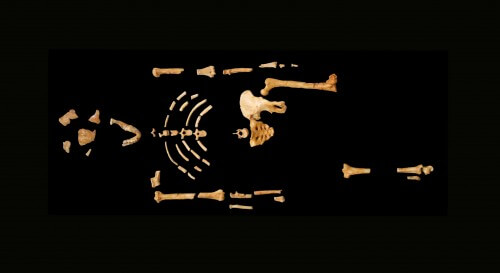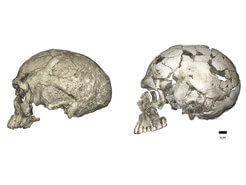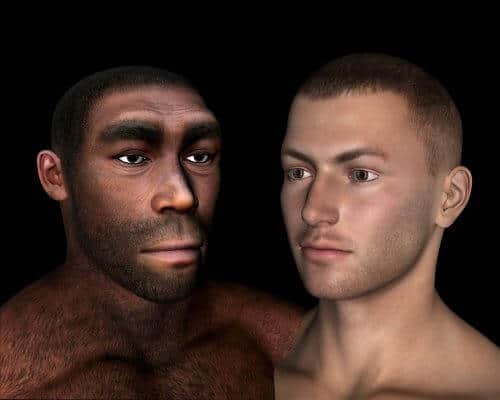The multiplicity of species and subspecies of primitive man has led researchers to a new hypothesis according to which the splits and reunifications of populations that were separated by natural barriers resulted in the combination of features developed in early hominids and the development of modern man

At first the story was quite simple, or at least there was one clear story. Our species evolved in Africa from a population of an earlier species, which over time evolved into the modern man we know today. There have been arguments about the exact location, or when man first appeared, but not about the assumption that the human race had a single starting point. Now an international team of researchers led by scientists from Great Britain and Germany offers a completely different approach, according to which our origin is all of Africa, and we inherited our traits from a multitude of different populations across the continent.

For a long time, researchers believed that humans originated in East Africa, where many human remains were discovered, including the famous "Lucy". Lucy belonged to the species Australopithecus afarensis (Australopithecus afarensis), which walked on two feet, but in many ways was more like a great ape than us. According to the story presented in the textbooks, from Australopithecus evolved Homo habilis (Homo habilis) who already made stone tools and used them, then Homo erectus (H. erectus), and maybe a few more on the way. In the end we got the modern man, Homo sapiens (H. sapiens).
Over time, the remains of Australopithecus, a species close to Lucy's, were also discovered in South Africa. A dispute developed between researchers who claimed that the origin of man is in East Africa, the region of Ethiopia and Kenya, and between those who preferred the south. It was also not clear where exactly in our evolutionary tree the multitude of species and subspecies, more or less close to man, found over the years should be placed.
The basic story, however, remains the same: one population that slowly developed the characteristics of modern man. These characteristics include a flat face without prominent eyebrow ridges, a pointed chin, a rounded skull, and also a developed technological culture. For a long time the consensus was that Homo sapiens, as we know it today, appeared about 200 thousand years ago.
But something didn't work out. Skulls that included some of the characteristics of modern man, but not all, began to be discovered in many places and many periods. South Africa 260 thousand years ago. Ethiopia about 195 thousand years ago. Then came the fossils from Morocco.
The skull found in Morocco was dated about a year ago to more than 300 thousand years before our time, and thus precedes the appearance of our species by a hundred thousand years. More than that: it includes North Africa in the list of places where, perhaps, modern man first developed.
The findings from Morocco (Photo: Reuters) (Photo: Reuters)
The findings from Morocco (Photo: Reuters)
On the other hand, the skull doesn't look quite like our skulls today. Like previous finds, it contains a combination of features: the face is small and flat, but the skull itself is very elongated and not rounded. What do we do with all these findings, which refuse to fit neatly into one evolutionary tree?
"If you look at the skulls, you see different characteristics of modern man emerge in different places and at different times," said Eleanor Scerri, who signed the new article, to the Atlantic magazine. The reason for this, in her opinion? "Our species has many African origins."
unite and separate
The researchers bring different types of evidence, both genetic and from the fossil record, to support their claim. They show how groups of early humans who lived in different places in Africa not only had different morphological features, but also developed a unique culture, as reflected in the stone tools and jewelry they left behind.
These groups were separated from each other for long periods by natural barriers such as deserts or rainforests. Climate changes led to changes in those barriers, and groups that lived at the same time for thousands of years and more suddenly met and shared knowledge, and also exchanged genes. This is joined by groups of species that are more distant, but still close enough to produce offspring with members of our own species. We have evidence that through such hybrids we received genes from different species throughout our history, from the Neanderthals through the Denisovans to mysterious African species whose identity we do not know.
The traits that characterize us today, the researchers claim, each developed in a different place, and came to us as a result of the meetings between the groups and the mixing between them. Ed Jung, who wrote about this in the "Atlantic", likened it to a series of streams that unite and diverge, all part of the same system but not necessarily originating from the same point. This is in contrast to the familiar image of an evolutionary tree, where all branches come from one trunk.

How did we get to the current situation where there is only one species of human, Homo sapiens? This question has no answer yet. It is not clear whether the other species and subspecies became extinct naturally, were exterminated by other species or assimilated within them until no external remains remained.
The new hypothesis looks very interesting, but more research is needed before we can determine if it is indeed valid. Siri also knows this: "We are only at the beginning," she said, "to know more about what happened we need more data from many areas in Africa that today we have no information about." The earliest fossils of Homo sapiens were found in ten percent of Africa, and we infer from this information about the other 90 percent of the continent. Most of it is still unexplored. We are basically saying that you don't need to look at all these places because we have the answer from the ten percent. But how can we know that this is the right answer?"
for the scientific article
For the announcement of the Max Planck Institute for Evolutionary Anthropology

7 תגובות
What are you confusing in your mind, how were they created and let's say in simple language, a mutation was born from a cup, and you want to tell me that humanity was created from this. And why would monkeys roll, who somehow formed a group and from which the world developed. In the 300 years of life, who are you working on, and it's not even related to religion. There are questions that are more intriguing, how did they get to the point where there are ships or when did they stop eating each other, yes, cannibalism and hundreds of other questions Seriously. Haha everything was created by the explosion of a science elk
Until when will the scientists bury their heads in the sand. They will search in vain for the missing link, the final product that is Homo sapiens is the result of foreign genetic manipulation, it is even explicitly written in the Bible, it was not a short process and full of errors, but the time has come to recognize such a possibility, especially in the light of knowledge The huge amount we have accumulated, it's time to get out of the box.
As always, reality is more complex than first thought.
At least we (at least those who do not take the scriptures seriously, or any self-respecting scientist) no longer believe in the myth of Adam and Eve. The myth (at least in part, because there is no real story) of the departure from East Africa will also change into a multitude of future stories.
We certainly have a long way ahead of us and many discoveries that will shed a brighter light on what we currently know, we just have to wait. 🙂
Who why do the ancient redwoods like the one featured in this article not have beards and long hair? Would they get a haircut and shave?
Nostradamus
You ask a good question - and the question has a good answer.
As you said, we see very large differences between people of different origins, but it turns out that the genetic differences are very small.
More than that - it turns out that the genetic differences between Australian aborigines and Danes are no greater than the differences within the Danish people themselves.
And why is it forbidden to assume that there are different races even today? Just so as not to offend members of a certain race harmed by science? Doesn't evolution work differently for different climates? If there is a difference in color, it is unlikely that there is also a difference in other features such as height, size and shape of organs, IQ....? Some people look different from each other like the aborigines for example
Makes a lot of sense. If Homo sapiens mated with at least two different species (Neanderthals and Denisovans)
Outside of Africa, it is likely (if not more so) that his ancestors found similar enough species as well
inside Africa to have offspring with them.